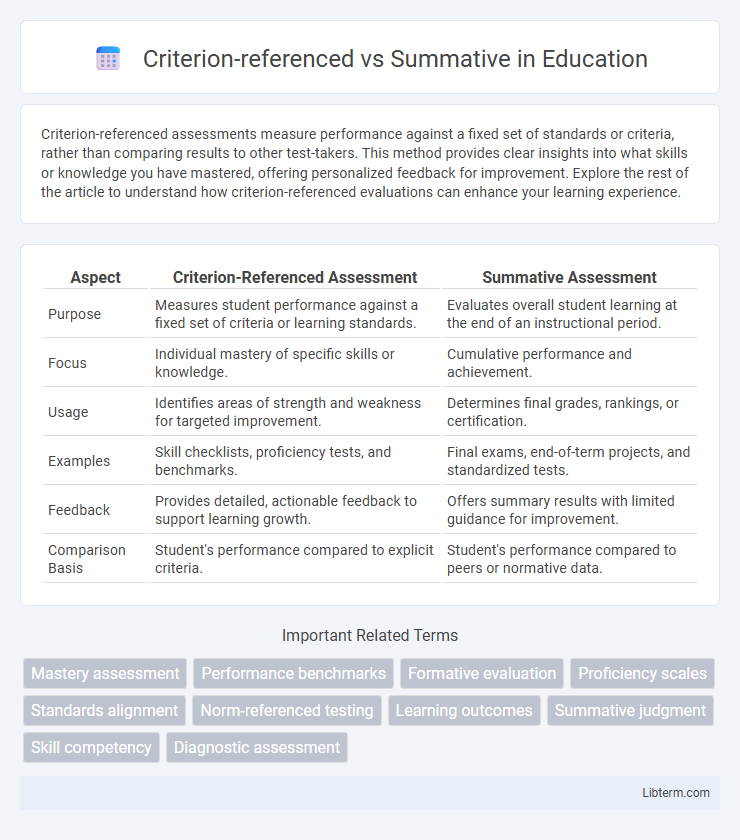Criterion-referenced assessments measure performance against a fixed set of standards or criteria, rather than comparing results to other test-takers. This method provides clear insights into what skills or knowledge you have mastered, offering personalized feedback for improvement. Explore the rest of the article to understand how criterion-referenced evaluations can enhance your learning experience.
Table of Comparison
| Aspect | Criterion-Referenced Assessment | Summative Assessment |
|---|---|---|
| Purpose | Measures student performance against a fixed set of criteria or learning standards. | Evaluates overall student learning at the end of an instructional period. |
| Focus | Individual mastery of specific skills or knowledge. | Cumulative performance and achievement. |
| Usage | Identifies areas of strength and weakness for targeted improvement. | Determines final grades, rankings, or certification. |
| Examples | Skill checklists, proficiency tests, and benchmarks. | Final exams, end-of-term projects, and standardized tests. |
| Feedback | Provides detailed, actionable feedback to support learning growth. | Offers summary results with limited guidance for improvement. |
| Comparison Basis | Student's performance compared to explicit criteria. | Student's performance compared to peers or normative data. |
Introduction to Assessment Types
Criterion-referenced assessment measures student performance against a fixed set of standards or learning criteria, ensuring mastery of specific skills or knowledge. Summative assessment evaluates overall student learning at the end of an instructional period by comparing results to predetermined benchmarks or grade-level expectations. Both assessment types play essential roles in educational evaluation, with criterion-referenced focusing on individual competency and summative providing a comprehensive overview of academic achievement.
Defining Criterion-Referenced Assessment
Criterion-referenced assessment evaluates student performance based on predefined learning objectives and specific criteria rather than comparing results to peers. It measures mastery of skills or knowledge by determining whether students meet established benchmarks, ensuring consistent and objective evaluation. This type of assessment provides detailed feedback on strengths and weaknesses related to instructional goals, facilitating targeted interventions and personalized learning.
Understanding Summative Assessment
Summative assessment evaluates student learning by measuring performance against predefined standards or learning objectives at the end of an instructional period. This type of assessment provides a comprehensive overview of student achievement, often influencing final grades and educational decisions. Unlike criterion-referenced assessments that compare performance to specific criteria, summative assessments summarize overall learning outcomes for accountability and validation purposes.
Purpose and Objectives of Each Approach
Criterion-referenced assessments evaluate student performance against predefined learning standards, aiming to determine whether specific skills or knowledge have been mastered. Summative assessments measure overall student achievement at the end of an instructional period, providing a comprehensive evaluation of learning outcomes. The primary objective of criterion-referenced assessment is to guide individual learning progress, while summative assessment focuses on assigning final grades or certifying competence.
Key Differences: Criterion-Referenced vs Summative
Criterion-referenced assessments measure student performance against predefined learning objectives, ensuring mastery of specific skills or knowledge. Summative assessments evaluate overall student learning at the end of an instructional period, often contributing to final grades or evaluations. The key difference lies in criterion-referenced tests assessing individual competence, while summative tests provide a comprehensive judgment of achievement.
Advantages of Criterion-Referenced Assessment
Criterion-referenced assessment offers precise measurement of student performance against specific learning standards, enabling targeted feedback and personalized instruction. It enhances instructional alignment by clearly identifying mastery of content, which supports effective remediation and enrichment. This type of assessment fosters equity by evaluating all students based on consistent criteria rather than relative performance.
Benefits of Summative Assessment
Summative assessment provides a clear measurement of student learning outcomes by evaluating performance against predetermined standards at the end of an instructional period, enhancing accountability and guiding educational decision-making. It offers valuable data for curriculum evaluation and helps identify areas for improvement in teaching methodologies. The use of summative assessment supports standardized testing frameworks and facilitates benchmarking across diverse educational settings.
Limitations and Challenges
Criterion-referenced assessments often face challenges in setting clear, measurable standards that accurately reflect diverse learner abilities, leading to potential subjectivity in interpretation. Summative assessments are limited by their emphasis on final outcomes, which can overlook ongoing learning processes and provide limited diagnostic feedback for improvement. Both assessment types may encounter difficulties in adapting to varied educational contexts and ensuring fairness across different student populations.
Choosing the Right Assessment for Your Needs
Choosing the right assessment depends on your specific goals: criterion-referenced assessments measure student performance against predefined learning standards, ideal for identifying mastery of skills. Summative assessments evaluate overall learning outcomes after instruction, useful for assigning grades or determining program effectiveness. Understanding these distinctions ensures selecting the most effective tool to accurately gauge student progress and instructional quality.
Conclusion: Which Assessment Is Most Effective?
Criterion-referenced assessments provide precise measures of student mastery against predefined standards, enabling targeted instructional improvements and personalized learning paths. Summative assessments offer broad evaluations of overall student performance at the end of an instructional period, effectively informing final grades and accountability systems. Combining both approaches optimizes educational outcomes by balancing detailed feedback with comprehensive evaluation.
Criterion-referenced Infographic

 libterm.com
libterm.com